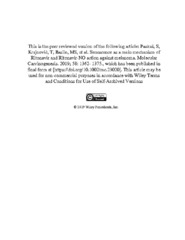Приказ основних података о документу
Senescence as a main mechanism of Ritonavir and Ritonavir‐NO action against melanoma
| dc.creator | Paskaš, Svetlana | |
| dc.creator | Krajnović, Tamara | |
| dc.creator | Basile, Maria S. | |
| dc.creator | Dunđerović, Duško | |
| dc.creator | Cavalli, Eugenio | |
| dc.creator | Mangano, Katia | |
| dc.creator | Mammana, Sant | |
| dc.creator | Al‐Abed, Yousef | |
| dc.creator | Nicoletti, Ferdinando | |
| dc.creator | Mijatović, Sanja | |
| dc.creator | Maksimović-Ivanić, Danijela | |
| dc.date.accessioned | 2020-07-17T08:57:00Z | |
| dc.date.available | 2020-07-01 | |
| dc.date.issued | 2019 | |
| dc.identifier.issn | 0899-1987 | |
| dc.identifier.uri | https://radar.ibiss.bg.ac.rs/handle/123456789/3780 | |
| dc.description.abstract | The main focus of this study is exploring the effect and mechanism of two HIVprotease inhibitors: Ritonavir and Ritonavir‐nitric oxide (Ritonavir‐NO) on in vitro growth of melanoma cell lines. NO modification significantly improved the antitumor potential of Ritonavir, as the IC50 values of Ritonavir‐NO were approximately two times lower than IC50 values of the parental compound. Our results showed for the first time, that both compounds induced senescence in primary and metastatic melanoma cell lines. This transformation was manifested as a change in cell morphology, enlargement of nuclei, increased cellular granulation, upregulation of β‐galactosidase activity, lipofuscin granules appearance, higher production of reactive oxygen species and persistent inhibition of proliferation. The expression of p53, as one of the key regulators of senescence, was upregulated after 48 hours of Ritonavir‐ NO treatment only in metastatic B16F10 cells, ranking it as a late‐response event. The development of senescent phenotype was consistent with the alteration of the cytoskeleton—as we observed diminished expression of vinculin, α‐actin, and β‐tubulin. Permanent inhibition of S6 protein by Ritonavir‐NO, but not Ritonavir, could be responsible for a stronger antiproliferative potential of the NO‐modified compound. Taken together, induction of senescent phenotype may provide an excellent platform for developing therapeutic approaches based on selective killing of senescent cells. | en |
| dc.language.iso | en | sr |
| dc.publisher | New Jersey: Wiley-VCH Verlag GmbH & Co | sr |
| dc.relation | info:eu-repo/grantAgreement/MESTD/Basic Research (BR or ON)/173013/RS// | sr |
| dc.relation | info:eu-repo/grantAgreement/MESTD/Integrated and Interdisciplinary Research (IIR or III)/41031/RS// | sr |
| dc.rights | embargoedAccess | sr |
| dc.source | Molecular Carcinogenesis | sr |
| dc.subject | HIV‐protease inhibitors | sr |
| dc.subject | Melanoma | sr |
| dc.subject | Ritonavir | sr |
| dc.subject | Senescence | sr |
| dc.title | Senescence as a main mechanism of Ritonavir and Ritonavir‐NO action against melanoma | en |
| dc.type | article | sr |
| dc.rights.license | ARR | sr |
| dcterms.abstract | Мангано, Катиа; Максимовић‐Иванић, Данијела; Мијатовић, Сања; Ницолетти, Фердинандо; Басиле, Мариа С.; Дунђеровић, Душко; Крајновић, Тамара; Маммана, Сант; Aл‐Aбед, Yоусеф; Паскаш, Светлана; Цавалли, Еугенио; Сенесценце ас а маин мецханисм оф Ритонавир анд Ритонавир‐НО ацтион агаинст меланома; Сенесценце ас а маин мецханисм оф Ритонавир анд Ритонавир‐НО ацтион агаинст меланома; | |
| dc.rights.holder | © 2019 Wiley Periodicals, Inc. | sr |
| dc.citation.issue | 8 | |
| dc.citation.volume | 58 | |
| dc.description.note | This is the peer reviewed version of the following article: Paskaš, S, Krajnović, T, Basile, MS, et al. Senescence as a main mechanism of Ritonavir and Ritonavir‐NO action against melanoma. Molecular Carcinogenesis. 2019; 58: 1362‐ 1375., which has been published in final form at [https://doi.org/10.1002/mc.23020]. This article may be used for non-commercial purposes in accordance with Wiley Terms and Conditions for Use of Self-Archived Versions | |
| dc.identifier.doi | 10.1002/mc.23020 | |
| dc.identifier.scopus | 2-s2.0-85064600105 | |
| dc.identifier.wos | 000474276900003 | |
| dc.citation.spage | 1362 | |
| dc.citation.epage | 1375 | |
| dc.type.version | acceptedVersion | sr |
| dc.identifier.fulltext | https://radar.ibiss.bg.ac.rs/bitstream/id/6505/a12rev.pdf | |
| dc.citation.rank | M21 |

